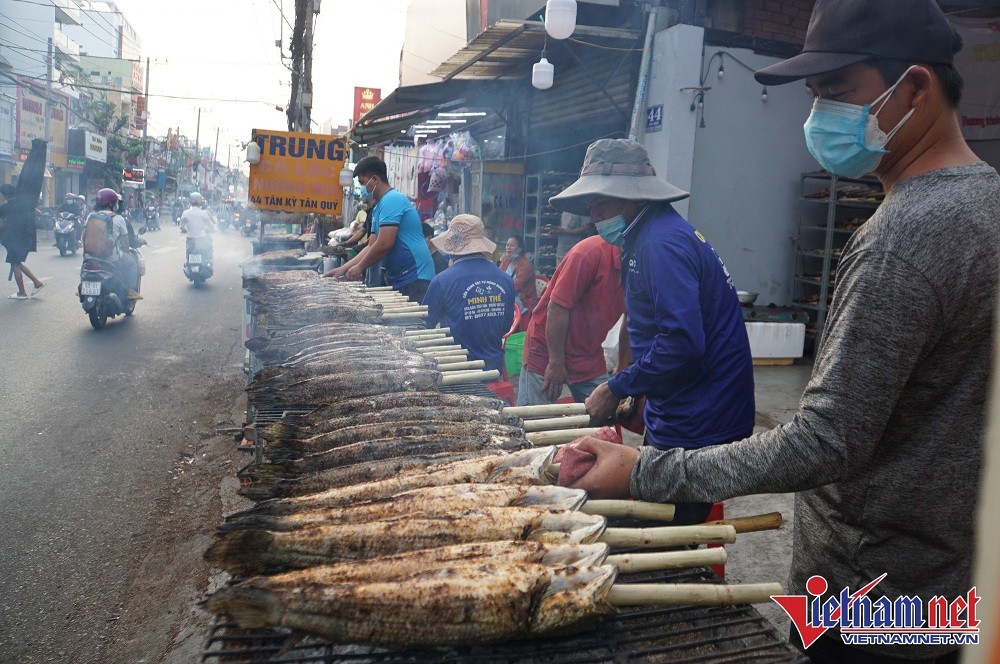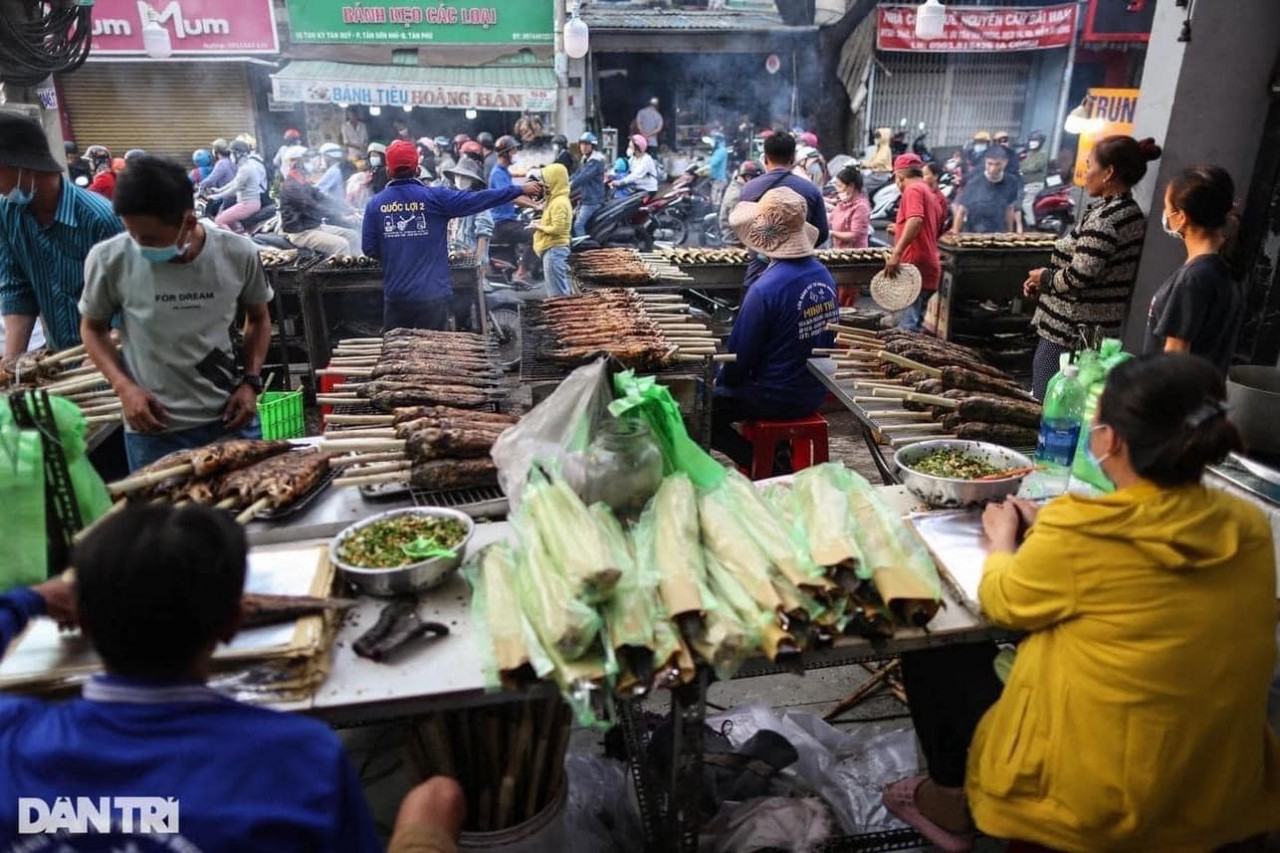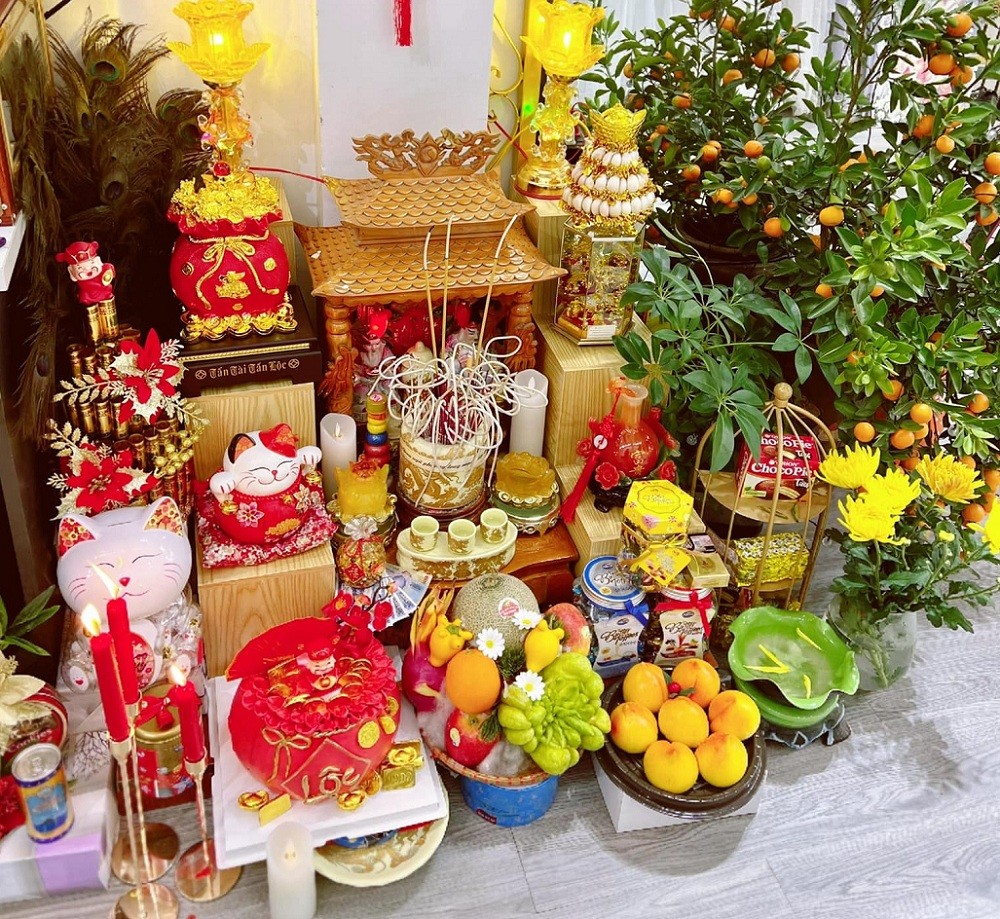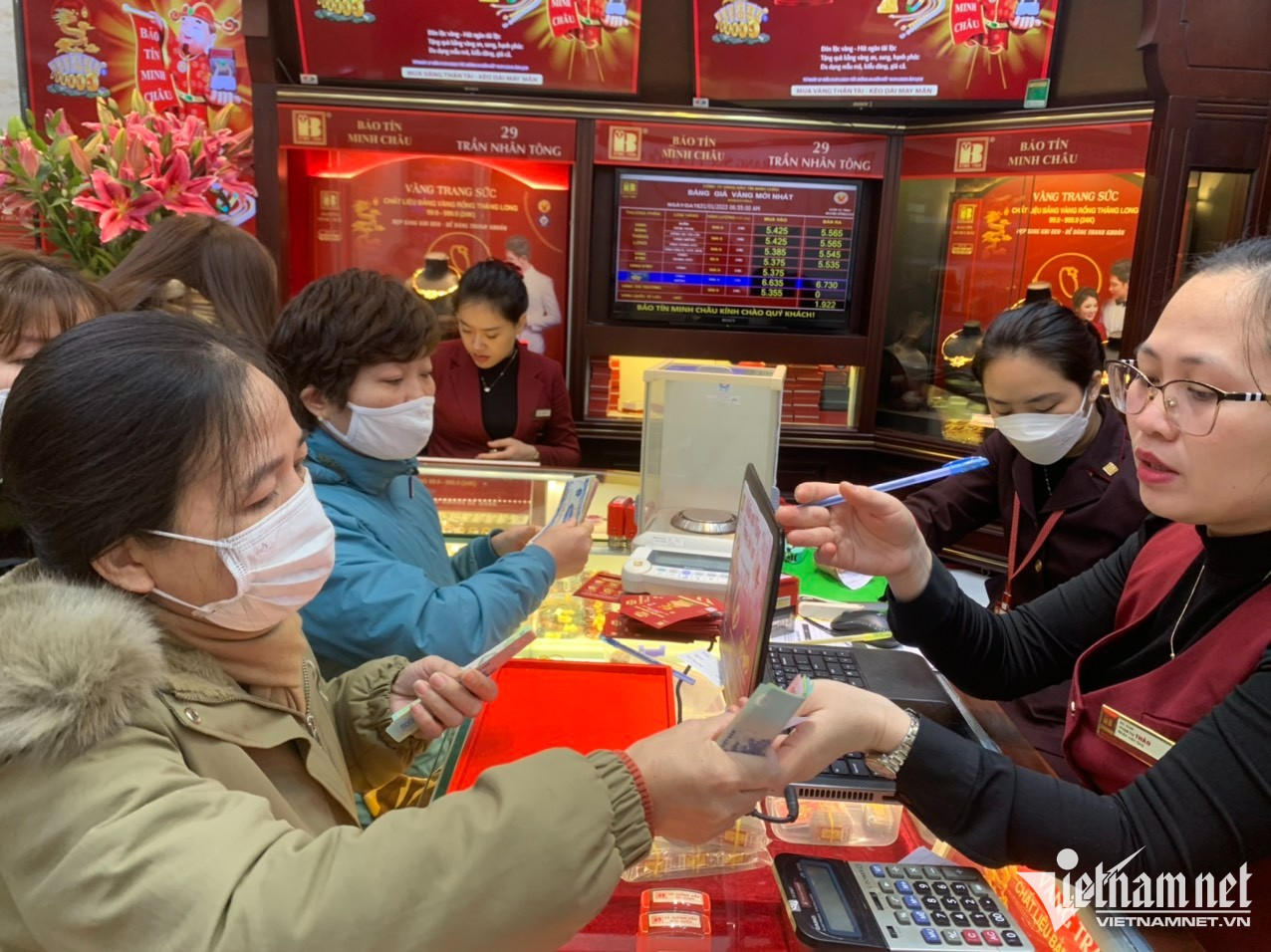On the day of the God of Wealth, grilled snakehead fish is the best-selling food item in the South. Do you know why there is always grilled snakehead fish here?
The God of Wealth (Caishen Day or Than Tai in Vietnamese), worshipped by families on the tenth day of the lunar year (January 31 this year), is believed to bring good fortune to their business and family through the year.
 |
| Smoke fills a corner of the street, packed with customers since morning. Source: Vietnamnet |
After selecting votive paper, flowers, and fruits, people buys snakehead fish, an essential offering for many Ho Chi Minh City’s residents on this day, on Tan Ky Tan Quy Street in Tan Phu District famed for this grilling dish.
Nearly a dozen stalls grilling tons of snakehead fish, a God of Wealth Day specialty, started selling at 4 a.m. to meet the high market demand. After the customer selects a fish, it will be garnished with green onions and roasted peanuts before being wrapped in foil.
Snakehead fish is a strong but gentle animal, not harmful to humans, considered to be able to bring luck and fortune. In addition, it is a very good source of nutrients for health. According to the tradition, you must offer a whole fish without scraping off the scales or removing the tail. Many agree that the fish here is beautifully grilled and tastes better than in many other places.
 |
| In the south, people usually make offerings of fruit, flowers, votive paper, incense, grilled meat and, unfailingly, grilled snakehead fish. Source: Dan Tri |
Roasted pork is among the three “must-have” offerings for southern families, which includes pieces of pork, shrimp (or crab), and duck eggs.
Locals believe roasted pork is a dish the God of Wealth often eat when descends to earth. According to folklore, the mouth of a snakehead fish is shaped like a Pixiu (a mythical animal from Chinese culture and a lucky symbol for wealth, good fortune, and protection), with its mouth wide open as if it were sucking fortune into their houses. That is also the reason why people offer snakehead fish to hope for good fortune and luck on the day of the God of Wealth.
People also buy gerbera daisies (hoa dong tien, meaning money flower in Vietnamese), hoping it would bring her good fortune on this special day.
Why do Southern people always have snakehead fish in the tray of worshiping the God of Wealth? Although a subject of much debate, there is no exact answer about the deep origin of this custom. Nevertheless, southerners continue to worship the snakehead fish.
The fish must be kept intact from head to tail, even without scales. Before grilling, must use scraped sugarcane to pierce the fish through the mouth to keep the body straight and beautiful. People abstain from offering to the God of Wealth the grilled fish that are burnt or peeled, chipped, and less pleasing to the eye.
However, depending on each family’s belief, people can also prepare vegetarian dishes and fruits as offerings.
 |
| People wipe the altar shrine, change the water, and offer flowers, pastries and fruit. People believe that in the coming year, all shall be in good order and that it is only once the Gods are cleaned that they may thrive in business. |
The custom of worshiping the God of Wealth at first was only spread among a small number of people doing business in HCM City, but about several years ago, it became very popular, even among people who did not believe in the tradition. Now, many businesses particpate in the worship by making offerings to the God of Wealth on this day to have a year of financial abundance.
The custom of worshiping the God of Wealth originated in China and was introduced to Vietnam around the beginning of the 20th century. Revolving around the daily beliefs are quite interesting related stories. The best known is the story of Zhao Gongming, who helped Jiang Ziya overthrow the Shang.
After his death in battle, Zhao Gongming was conferred a title as Zhengyi Xuantan Marshal, ruled over the four heavenly gods Chen Jiugong, the god of attracting wealth; Xiao Sheng, the god of collecting treasures; Cao Bao, the god of collecting valuables; and Yao Shaosi, the god of profitability. He and his four disciples are also known as the “five directions” of the Chinese Gods of Wealth.
He is often depicted riding a black tiger and holding a golden rod. He may also be depicted with an iron tool capable of turning stone and iron into gold.
|
The God of Wealth (Thần Tài) and the God of Earth (Ông Địa) are the two gods who are believed to bring good fortune and luck to people’s business and family, and therefore are worshiped by many households in Vietnam. Together, the God of Wealth and and God of Earth adorn the shrines that are set close against the ground and turned to face the main entrances of houses. The gods are reverently and earnestly worshipped with the hope that, owing to the deities’ vouchsafement, they would issue wealth and fortune. |
According to another story, the God of Wealth used to reside in heaven however, due to excessive drinking, he fell into the world and lost his memory. From then on, he started begging for daily essentials to survive.
The story says, the God of Wealth accidentally met an owner of an eatery. He was then invited for a hearty meal which then marked the first time that the eatery was flooded with customers. The eatery owner then begged the man to stay as he sees it beneficial to his business.
On the 10th day of the God of Wealth’s stay, he suddenly gained his memory back and returned to heaven. And with that, it is believed that the 10th day of each month is the day of the God of Wealth. On this day, families with business pray for a new year of great fortune and wealth.
 |
| The 10th day of the Lunar New Year is the God of Wealth Day, when Vietnamese buy gold to bring fortune and prosperity for the coming year. Source: Vietnamnet |
Many people believe buying a piece of gold on the day, brings good fortune, and prosperity to their business and family through the year.
Buying gold on this day used to be a tradition only among businessmen, especially ethnic Chinese, but in the last few years it has been embraced by the wider population in Hanoi and HCM City. Around this time, the gold purchases usually skyrockets.
This year, besides traditional figurines of the God of Wealth inscribed with the words Phúc (Happiness), Lộc (Prosperity), Thọ (Longevity), and Tài (Wealth), the 12 zodiac animals and lucky charm bracelets made of 24k and 18k gold, companies have also launched a wide selection of cat-inspired statues and jewellery since this is the Year of the Cat.
Worshiping tray on Kitchen God Day in different regions of Vietnam
On the 23rd day of the last Lunar month, every Vietnamese family prepares a decent food tray to send the Kitchen God (Tao Quan) to heaven. Depending on local traditions, each region in Vietnam has its special way to offer the Kitchen God.
Celebration of Vu Lan Festival in the 7th Lunar Month Among Vietnamese People
In Vietnam, the 7th full moon festival is called “Vu Lan bao hieu” (Parents’ Day) or “Xa toi vong nhan” (Wandering Soul’s Day). This is the second largest annual traditional festival in Vietnam after the lunar New Year (Tet) festival, and is celebrated by Vietnamese people through various religious rituals.








